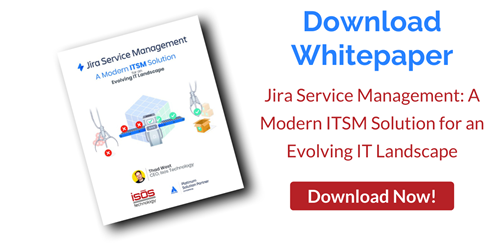
The IT Service Desk serves as a front-line point for customer contact and an essential part of the customer experience. It’s also a strategic platform for supporting internal business functions; a foundational part of the critical DevOps feedback loop; and an integral tool in the management of unplanned and potentially disruptive events that are so much a part of both the world and business today. Yet many companies find themselves struggling with aging ITSM technology that doesn’t support these types of experiences.
If it’s time to update your service desk platform to something that will solve today’s business problems and serve you well into the future, here are five great reasons that will help you make a business case for investing in a platform like Atlassian’s Jira Service Management.
#1. To Support Self Service
If your service desk platform doesn’t have an integrated knowledge base or wiki, you’re working harder, not smarter. With a quick search of a wiki or knowledge base, customers can often find the answers they are looking for, so they don’t even need to submit a ticket and wait for a response. The ITSM team benefits from this approach, too—a reduced number of tickets submitted means they can focus on more complex issues. JSM is integrated with Confluence, Atlassian’s collaboration and knowledge base tool, so customers can quickly and easily find answers they’re looking for.
#2. To Increase the Customer’s Visibility into the Process
No one likes to be kept in the dark! Whether they call in or log on to submit a ticket, customers want to see and track the progress of that ticket in real time, in much the same way that they can see an Uber or Lyft on its way to pick them up and take them to their destination. With JSM, you can customize notifications, so customers get updates on the progress of their ticket.
#3. To Better Support Other Internal Departments
A lot of companies want to minimize the number of applications in use by their various divisions and departments. This improves visibility and collaboration, can be less costly, and simplifies things for IT teams that support the tools. JSM is flexible enough to support any department that takes in requests, including marketing, human resources, accounting, legal, facilities, and more.
#4: To Integrate with the DevOps Feedback Loop
DevOps is driving more frequent updates and deployments than ever, and IT service desks are on the front lines in terms of capturing feedback when changes are made. But if the ITSM software doesn’t integrate well with the tools the DevOps team is using, there’s no way to get that important information into the DevOps feedback loop. As part of the Atlassian ecosystem, JSM easily integrates with tools like Jira Software that engineering, development, and operations teams are already using.
#5: To Better Manage Changing Business Needs and Unplanned Events
Regardless of industry, companies today are dealing with dynamic business environments. Things like rapid growth, a merger or acquisition, or a disruptive event like a security issue (or pandemic) are increasingly common. To manage these changes, organizations must have agile, resilient systems in place that allow them to scale up, scale down, work collaboratively across departments, manage an influx of requests, and extend technology and services to other areas of the business, all without the heavy lift of one-off customizations and integrations. JSM, like all Atlassian tools, is a great solution for that!
Sign up to receive more great content
Learn more about Atlassian and how Isos can help by signing up to receive our latest blogs, eBooks, whitepapers and more.














